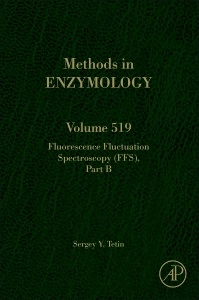Description
Fluorescence Fluctuation Spectroscopy (FFS) Part B
Methods in Enzymology Series
Author: Tetin Sergey
Language: English
Subjects for Fluorescence Fluctuation Spectroscopy (FFS) Part B:
376 p. · 15x22.8 cm · Hardback
Description
/li>Contents
/li>Readership
/li>Comment
/li>
This new volume of Methods in Enzymology continues the legacy of this premier serial with quality chapters authored by leaders in the field. This volume covers fluorescence fluctuation spectroscopy and includes chapters on such topics as Förster resonance energy transfer (fret) with fluctuation algorithms, protein corona on nanoparticles by FCS, and FFS approaches to the study of receptors in live cells.
- FCS in STED Microscopy: Studying the Nanoscale of Lipid Membrane Dynamics
- Fluorescence Fluctuation Spectroscopy Approaches to the Study of Receptors in Live Cells
- Studying the Protein Corona on Nanoparticles By FCS
- Studying Antibody – Antigen Interactions with Fluorescence Fluctuation Spectroscopy
- Fluorescence Fluctuation Approaches to the Study of Adhesion and Signaling
- Interactions in Gene Expression Networks Studied by Two-Photon Fluorescence Fluctuation Spectroscopy
- Studying Ion Exchange in Solution and at Biological Membranes by FCS
- Fluctuation Analysis of Activity Biosensor Images for the Study of Information Flow in Signaling Pathways
- Probing the Plasma Membrane Organization in Living Cells by Spot Variation Fluorescence Correlation Spectroscopy
Biochemists, biophysicists, molecular biologists, analytical chemists, and physiologists
- Continues the legacy of this premier serial with quality chapters authored by leaders in the field
- Covers fluorescence fluctuation spectroscopy
- Contains chapters on such topics as Förster resonance energy transfer (fret) with fluctuation algorithms, protein corona on nanoparticles by FCS, and FFS approaches to the study of receptors in live cells




